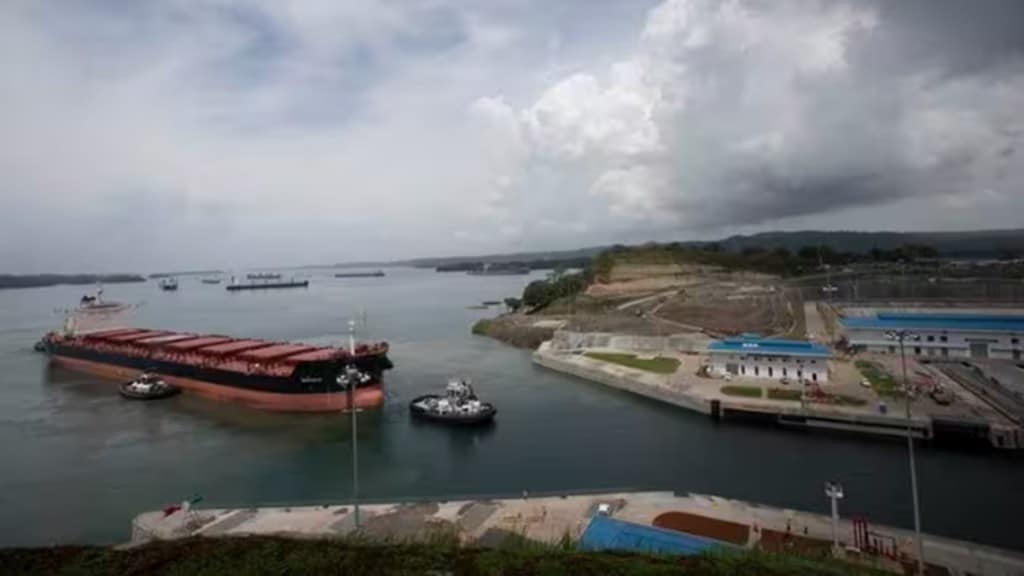The Panama Canal is a vital aquatic pathway that spans 82 kilometers, connecting the Caribbean Sea and the Pacific Ocean. Operating with locks and a unique water staircase mechanism, it facilitates the passage of ships, consuming 200 million litres of fresh water for each voyage. However, the canal faces challenges due to insufficient water levels caused by an ongoing environmental predicament. This disruption in ship navigation is influenced by a drought during the typical rainy period, resulting in lowered water levels in Gatun and Alajuela lakes.
The reasons for the reduced rainfall vary, with some attributing it to human activities and others to Earth’s historical fluctuations. Regardless of the cause, the consequences are undeniable. This prolonged dry season not only affects ship navigation but also jeopardizes the country’s drinking water supply, highlighting the high demand for fresh water on both sides.
While the “El Niño” phenomenon contributes to the issue, it’s important to note that the reduced rainfall exacerbates the situation. “El Niño” is a cyclical climatic phenomenon caused by warming waters in the equatorial Pacific Ocean. This occurrence warms the atmosphere and affects global circulation patterns, including the jet stream over the Pacific Ocean.
The challenge also impacts the global supply chain, particularly for goods destined for the eastern coast of the United States. In 2022, out of the total cargo of 95 million tons passing through the canal, 61.6% reached the eastern U.S. coast. The canal remains operational but with restrictions, allowing only 32 ships to cross per day, each with a maximum draft of 44 feet (13.41 meters). This limitation increases transportation costs as boat owners must carry less cargo.
Addressing this challenge requires short-term solutions to mitigate its impact. These solutions involve waiting for potential shifts in rainfall patterns and embracing innovative approaches. This could include developing new infrastructure and water supply sources. As the situation evolves, it’s essential to find ways to ensure the continued efficient operation of the Panama Canal, which plays a crucial role in global trade.
Cristhian A. Salamanca Garcia and Ivan D. Medina Rojas, experts in International Business and bio-business respectively, recognize the complexities of the issue and emphasize the need for collaborative efforts to navigate these challenges and sustain the Panama Canal’s vital role in international commerce.
Following are excerpts from a conversation with Cristhian A Salamanca Garcia and Ivan D Medina Rojas on the impact of the lower water levels on international trade:
Cristhian Salamanca Garcia, professional in International Business, Trade Promotion, and Intercultural Management, says: “With 170 user countries, an annual average of over 12,000 transits, and facilitating the movement of more than 95 million tons of cargo, the Panama Canal, an aquatic pathway linking the Caribbean Sea and the Pacific Ocean, traverses the narrowest point of the Panama Isthmus, spanning 82 kilometres in length. The Panama Canal operates as a system of locks that enables ships to ascend and descend between oceans using a water staircase mechanism, distinct from utilizing seawater. Each voyage through the Canal consumes 200 million litres of fresh water drawn from a hydrographic basin via Gatun and Alajuela lakes.”
Ivan D. Medina, professor at Uniminuto of bio-business and internationalization of SMEs, tells Financial Express Online: “The Panama Canal faces a formidable challenge where numerous vessels encounter obstacles in crossing the passage due to insufficient water levels required for safe transit. The ongoing environmental predicament, marked by a drought during the period when rainfall is typical, has precipitated disruptions in ship navigation through the canal.”
According to him, “The reasons for the diminished rainfall vary—some attribute it to human activities, while others perceive it as a manifestation of Earth’s historical fluctuations. However, the consequences are indisputable. This extended dry season has caused water levels in both Gatun and Alajuela lakes to plummet considerably below their seasonal norms, which also jeopardizes the country’s drinking water supply. A substantial demand for fresh water is evident on both sides.”
Is the issue solely attributed to the “El Niño” phenomenon?
No, says Cristhian Salamanca Garcia. “It’s a result of reduced rainfall compounded by the effects of “El Niño,” which leads to drought. “El Niño” is a climatic phenomenon recurring at specific intervals (every 3 to 7 years) due to the warming of waters in the eastern equatorial Pacific Ocean. Normally, these warm Pacific waters are pushed westward toward Asia by prevailing trade winds,” he explains.
Adding, “However, when these winds wane, the warm waters shift eastward within the Pacific Ocean. This occurrence warms the atmosphere and alters global circulation patterns, particularly the jet stream over the Pacific Ocean. Official records of “El Niño” date back to 1892 when Peruvian captain Camilo Carrillo reported the phenomenon.”
Also, “This situation presents a challenge to the global supply chain, notably for goods destined for the eastern coast of the United States. In 2022, out of the total cargo of 95 million tons transiting the canal, a subset of 58.9 million tons (61.6 percent of the total) reached the eastern US coast: 40.8 million tons (69.2 percent) from Asia, 10.6 million tons (17.99 percent) from the eastern coast of South America, and 4.1 million tons (6.9 percent) from the eastern coast of Central America.”
Is the Panama Canal Closed?
No. It must be said that the Canal is not closed, the movement of ships is still in force, but it operates with restrictions like only 32 ships can cross per day and each vessel cannot exceed a maximum draft of 44 feet (13.41 meters), so boat owners must transport less cargo, making trips more expensive. It is estimated that these restrictions will remain in force for one year.
“Considering these circumstances, the challenge needs a short-term solution to mitigate the impact of this phenomenon. This involves both waiting for potential shifts in rainfall patterns and embracing innovative approaches, including a form of controlled transformation that addresses the observed scenario. This entails developing new infrastructure and sources for water supply,” Ivan Medina, explains.


